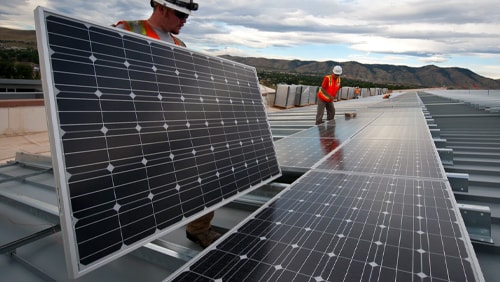
Any technology that makes its way to mainstream use goes through various degrees of improvement. Cell phones, when first introduced, were called bricks for very good reason and, now, are incredibly light, inexpensive (unless you’re dead set on owning an iPhone) and manageable. Large-screen TVs used to weigh a ton and required a bulldozer if you wanted to move them to a new location. Fast-forward to today, where the prices are much more accessible and the devices weigh virtually nothing, allowing them to be installed anywhere. Solar energy technology has followed the same path, and some of the panels being developed today are incredibly advanced compared to their predecessors.
Now, solar energy panels are flexible and “printable” – they’re not quite ready for a home printing job, but maybe that’s down the road. In the meantime, the newest step in solar innovation promises to offer tremendous flexibility with regards to where and how solar energy production is possible. It should also help bring down the cost substantially.
The University of Newcastle in Australia is helping push the introduction of the new panels for commercial use. They use organic solar cell technology, built on perovskite solar cells, to offer a low-cost and flexible solar energy solution. Perovskites, as described by Science Direct, are “synthetic compounds that have an orthorhombic crystal structure identical to the naturally occurring mineral with the same name and that share a structurally similar chemical formula.”
Perovskite-based solar modules were developed by the University of Newcastle by lead inventor professor Paul Dastoor and his team. They’re already beginning to see installation, such as that in a greenspace development in Lane Cove in New South Wales. Dastoor explains, “Globally, there’s been so few of these installations, we know very little about how they perform in a public setting. This installation is the next critical step in accelerating the development and commercialisation of this technology. It presents a new scenario for us to test performance and durability against a range of new challenges.”
The lighter, thinner panels provide a number of positive benefits. The amount of space needed, shipping costs and installation costs are all substantially reduced, and the panels can more easily be distributed to any part of the world. In addition, because the solar cells are organic and are housed in a contained made of PET material, 99% of the modules can be recycled when their lifespan ends.
Adds Dastoor, “This technology will really disrupt and revitalise the contracting print industry. Printed solar is manufactured on conventional printers – our lab-scale system previously manufactured wine labels. As a diverse team of physicists, chemists, engineers and educators, we’re considering not just the scaling of material production, but the education and training framework that will wrap around the industry to train and retrain an entirely new workforce.”
There have been other solar energy innovations over the years, such as a solar energy paint or solar energy roofing tiles, that also offer a lot of promise. However, organic perovskite panels could really help the solar energy space shine brightly.